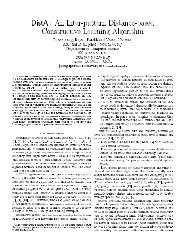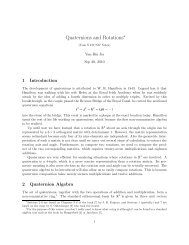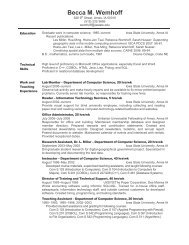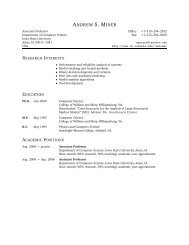1 Quorum System
1 Quorum System
1 Quorum System
You also want an ePaper? Increase the reach of your titles
YUMPU automatically turns print PDFs into web optimized ePapers that Google loves.
1.5 Process failures<br />
Following are the usual kind of failures that typically occur by object/process in both shared<br />
memory and message-passing systems.<br />
Definition 6 If a process behaves correctly according to its protocol, then it’s correct. A<br />
crash failure is one where the process (or shared object) stops executing protocol permanently.<br />
A process is benign if it’s correct or it has a crash failure. A process that is not benign is<br />
called Byzantine or malicious.<br />
Byzantine failures are the worst kind of failures. They can be again of two types:<br />
1. Unauthenticated: Here, a process can pretend to be some other process and can possibly<br />
forge signature of others. Processes can send arbitrary messages in message passing<br />
model or invoke arbitrary operations in shared memory model.<br />
2. Authenticated: We assume digital signature of each process in this type of failure of<br />
Byzantine failure and thus no process can forge other process’s signature.<br />
Definition 7 A fault configuration is a vector C ∈ {0, 1} n such that C i = 1 if and only if<br />
the process s i has failed.<br />
Definition 8 Given a set of processes S and an execution e, we define alive(e, S) as the set<br />
of correct processes in S, and faulty(e, S) as the set of faulty processes in S.<br />
We’ll write them as alive(S) and faulty(S), when e is clear from the context.<br />
Definition 9 A set of processes Q ⊆ S is available if Q ⊆ alive(S).<br />
We also consider probabilistic fault-tolerant model, where each process s i in the set S fails<br />
independently with probability p i .<br />
Definition 10 If p i = p for all i, then it’s called a uniform probabilistic fault tolerant model.<br />
References<br />
[Thomas, 1979] Thomas, R. H. (1979). A majority consensus approach to concurrency control<br />
for multiple copy databases. ACM Trans. Database Syst., 4(2):180–209.<br />
4















